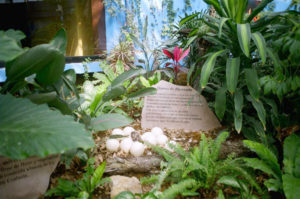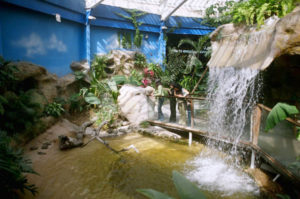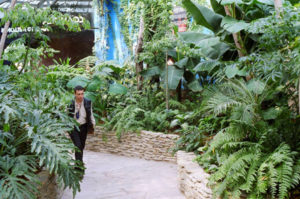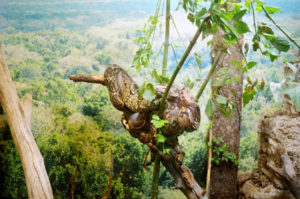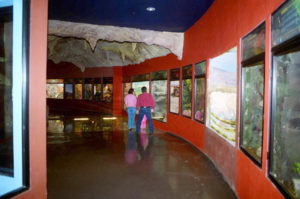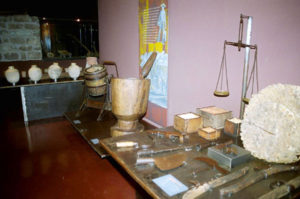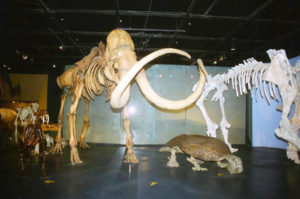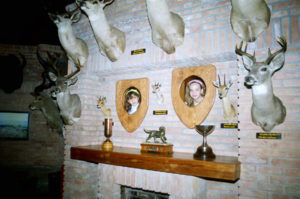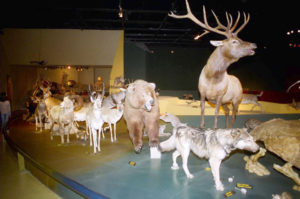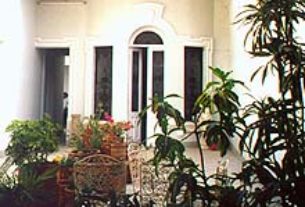Travels With Travis
A cool waterfall rushes over rocks into a pool surrounded by Boston ferns, split-leaf philodendron and magnolias in the desert of the northern Mexican state of Coahuila. Turtles bask on the shore, iguanas stare through a window into the herpetarium in the next room, and dinosaur eggs lay nestled beneath lush foliage.
The biodome of the Museo del Desierto – Museum of the Desert – on the outskirts of Saltillo, Coahuila, is just one of the many new attractions at the museum, where state of the art technology educates the public about every aspect of desert life. Wandering walkways take visitors through four pavilions filled with visual signs and exhibits, touch screens, video and sound effects to explain how man and animal have adapted to the desert throughout history. Children of all ages will enjoy the interactive media, pressing buttons to light up photos of plants and dinosaurs, peering through a window at scientists studying dinosaur fossils, and touching video screens to bring up images of desert wildlife with easy-to-read narratives. Everything’s in Spanish, so this is a good time to brush up on the language. However, even if you don’t, it’s still a fascinating place to visit, as you’ll soon discover.
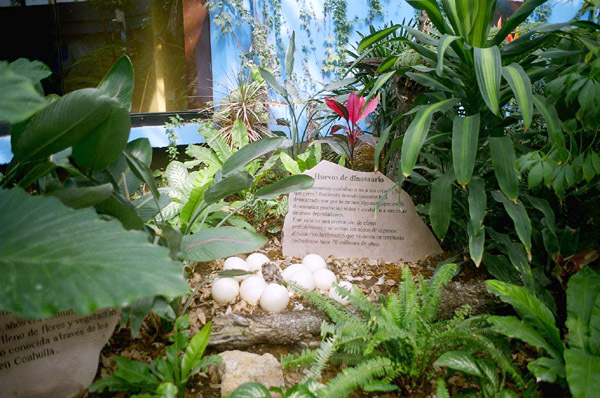
The Museum of the Desert opened in 1999 and covers 33,000 square meters of indoor exhibits and outdoor areas landscaped with desert plants. I paid my first visit here in 2001 and have made it a must-see on every trip to Saltillo. The biodome recreates parts of Coahuila as it existed 70 million years ago; other new attractions include the new pabellon on “Evolution and Biodiversity” with huge replicas of mammoth and mastodon skeletons, descriptions of how man and animal have interacted with biodiversity, and the herpetarium. The museum opened its “Living Desert” exhibit, with live bears and wolves, in 2006.
The museum, like the desert itself, never ceases to reveal new surprises and new secrets. Some of the older exhibits, however, are still here, and they still impress me with their vivid color and imaginative creations. The first pavilion, El Desierto y Su Pasado (The Desert and its Past), greets me with eerie music of a desert filled with life; the sounds of wind and rain, wind chimes, birds and crickets draw me into the spell of desert life as I pass displays of desert plants, and then suddenly to my left I see the replicas of dinosaur skeletons rising from a lower room.
With their gaping grimace leering at me, I turn to check out the plant exhibits, which explain how desert plants have adapted to dry conditions. The nopal tunas, for example, grow vertically so that when the sun is at its highest – and hottest – it won’t cover the whole surface of the cactus, thereby avoiding excessive heat.
I pass a large window into a lower room where scientists are studying dinosaur bones, then I move on toward discussions of how various animals, such as rabbits, snakes and bats, have adapted to the desert.
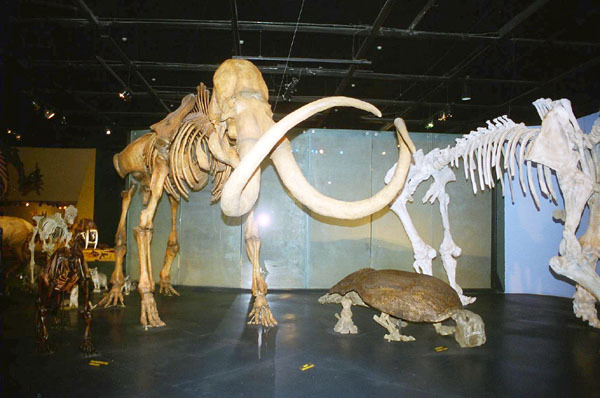
I approach a touch screen with the words Habitos Nocturnos (Nocturnal Habits), and the words Toca la Pantalla (touch the screen). The background has a picture of a yellow-eyed owl perched on a branch, then it fades into a picture of a yellow, bleary-eyed owlet, then a brown bat with outstretched wings appears and dives fiercely into red cactus blooms. Prompts allow visitors to learn more about owls, bats or kangaroo rats, about their feeding patterns, housing and reproduction.
Later, in one of the new displays, bats get even further publicity, with enclosures of live bats flying about or hanging from stalactites; in another case, a mounted bat dips its nose into a cactus flower, another alights on a cattail, and still another snatches up a scorpion.
The museum emphasizes hunting as an integral part of desert ecology; it is how man and animal have interacted with the world’s biodiversity, and this is as true in the desert as anywhere else.
“Hunting is a natural event of animals and people,” reads a sign in a new exhibit called “Man and the Use of Biodiversity,” which includes a display of arrowheads and rock paintings on one side of the walkway and coyotes attacking deer on the other.
“People have been in Coahuila for 12,000 years,” says the display. “Man made the atlatl (spear thrower) and the bow and arrow and fished with nets, arrows and traps.” This is a perfect complement to one of the other new exhibits inside, where huge replicas of mammoth and mastodon skeletons rise from the floor. A saber tooth tiger prowls nearby, overshadowed by the skeleton of a bear rising up on its hind legs, its jagged teeth gaping open. Beyond that is a menagerie stuffed prairie dogs, bears, raccoons, gray wolves and other animals, rather crowded, perhaps, but the meaning is clear – the desert of Coahuila is, and always has been, a vibrant place.
An older exhibit, in the pavilion titled, El Hombre y el Desierto – Man and the Desert, educates the public about the history of the American Indians and the lives of the early European settlers.
The rooms here are filled with old butter churns, wagons, earthenware jars and tubs, hammers, spurs, shears, metates, shoe maker’s tools, screws, metal seed planters and carpenter’s tools; hammers, clothes irons, tongs, bellows and chisels cover another table. The museum’s sound effects resurrect the history of these tools, brings them to life with the ringing of church bells, the bleating of sheep and goats, and the splashing of water and chickens cackling. Horses whinny as their metal horseshoes clop-clop-clop on stone streets through marketplaces busy with the voices of people bartering for goods.
Moving forward to more contemporary times I find an exhibit titled “House of the Hunter,” a room filled with mounted heads of moose, caribou, zebra, deer and other animals (children love poking their heads through holes in the walls next to the mounts), plus displays of old flintlocks, bolt action rifles and trophies for shooting competitions.
A nearby sign titled “The New Hunter” says that 21st-century hunting methods have taken into account the importance of protecting species and biodiversity. Technology allows people to track animals and learn about their habits, and regulated hunting allows for the conservation of biodiversity and creates a much-needed cash flow.
There’s a pretty steady flow of people through the museum, especially the new herpetarium, in which snakes and lizards from Mexico and other parts of the world populate glass enclosures where the makers of the exhibit have skillfully recreated a broad range of habitats for each reptile.
Children run excitedly down the wide hallway past rattlesnakes writhing in hot sand, a Burmese python in a green jungle, an iguana lounging stone-faced on a branch. Several types of rattlesnake call the herpetarium home. Scaly lizards with black velvet, viridian green and bright amber markings sprawl on ledges of a small rock wall.
Leaving the herpetarium, I immediately enter the green, humid, sun-lit biodome where I find just a trace of Coahuila millions of years ago.
“At this time,” says a sign, “large marshy extensions covered some desert zones of Coahuila and the climate varied from tropical to subtropical with a very elevated humidity. This type of environment allowed the existence of very exuberant vegetation adapted specifically to this climate.”
The sound of rushing water and taste of humidity heavy in the air infects me with a feeling of untamed abandon; the presence along the walkway of a hatchling breaking out of an egg in a dinosaur’s nest, and a dinosaur footprint nearby, complete the primal effect. The biodome serves as a celebration of Coahuila’s biodiversity both past and present, a reflection of ancient prehistory reconstituted for visitors.
I quickly return to the present when I enter a small snack bar where vendors sell chips, candy, cookies, and Cokes, Fresca or Sprite. A huge window on one side of the snack bar allows visitors to look at the prairie dog town outside while they enjoy their snacks. Finishing their snacks, they can go outside, up a winding walkway to a cactus garden and nursery.
The Museum of the Desert in Saltillo, always changing, always exploring, offers visitors the opportunity to make an intimate, fun and educational connection to the desert of northern Mexico. The diversity of the desert, reflected in the creative exhibits at this museum, is a great way to broaden the range of experiences for travelers in Mexico.
The Museum lies on the outskirts of town, at Prolongación Pérez Treviño, No. 3745 in Parque Las Maravillas. It’s better to catch a taxi from the old historic center. The drivers can get you there a lot faster – and easier – than you could get there on your own.
Entrance fee is currently 63 pesos.
Museo del Desierto Prolongación Pérez Treviño No. 3745 Parque Las Maravillas Saltillo, Coahuila C.P 25000 Tel. (8) 410-64-68

